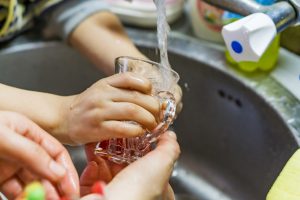
Today is Imagine a Day Without Water. Along with hundreds of other organizations across the world, we are recognizing this precious resource upon which are lives all depend. For those of us fortunate enough to rarely think about our water, where it comes from, and what is in it, today is an important opportunity to recognize that families throughout America and billions of people across the world cannot turn on a faucet today and access safe water. And today is a chance to ask ourselves, “What are we going to do about it?”
For too many Wisconsin residents, this is just another day without clean water that requires no imagination. Across our state, tens of thousands of people have unsafe drinking water because of high nitrate or pesticide levels, primarily from agricultural sources, PFAS contamination from manufacturing, firefighting foam use and disposal of PFAS-containing products, and decades-old pipes that leach lead and poison children.
Some of these water contaminants, like nitrates and lead, have been around for decades. While we have been aware of the health risks they pose, we learn more every day about just how harmful they can be. Others, like PFAS, have only recently come to our attention as limited testing has found them across Wisconsin and the nation. Often called “forever chemicals” because they will not break down in the environment, PFAS is group of thousands of chemicals used in countless products like Teflon and other non-stick cookware, stain and water-resistant clothing, food packaging and firefighting foam. The health risks these water contaminants pose to us and especially our children are alarming—birth defects, lifetime learning disabilities, increased cancer risks and reproductive harm, among many others.
While some resources are available to help families with contaminated water, much of this burden is left for them to bear. They face the expense and inconvenience of paying out of pocket to buy bottled water or installing expensive filtration systems. In cases where money might be tight, or where people don’t even know their water is contaminated, the burdens they bear are the health risks and complications that come with consuming polluted drinking water.
In the richest country in the world, in a state blessed with abundant water resources, this reality is simply unacceptable. Lawmakers in Wisconsin must begin to address this statewide drinking water contamination crisis by working to make sure every family who does not have access to clean drinking water gets it as soon as possible. That means investing in filtration, bottled water, well replacement, and other measures to get them that access.
We must also scale up testing and educational resources so people are better aware of the risks drinking contaminated water poses and how to test their water. All these contaminants are odorless, tasteless and impossible to detect without proper testing. Yet some special interest groups in Wisconsin are currently standing in the way of more testing resources for the simple reason that if we don’t know the pollution is there, then we don’t have to do anything about it. Blissful ignorance is their chosen path, and the burden of that ignorance is placed squarely on Wisconsin families.
We must also begin in earnest to clean up our polluted water resources and to prevent more pollution from getting into our water. That means bold and lasting investments from the state and federal government in removing lead pipes, helping farmers change the way they farm to reduce water pollution, and in working with businesses and local governments to reduce the use of PFAS compounds that pose public health risks while cleaning up the pollution already out there.
None of these solutions are cheap or easy, but they are all already on the table. In Wisconsin, the Governor’s proposed budget had extensive resources for PFAS testing and cleanup and tens of millions of dollars to remove lead pipes. In conjunction with other agricultural and conservation groups, Clean Wisconsin put forward a proposal to spend $50 million dollars a year for testing, remediation and agricultural conservation efforts to address nitrate contamination. In a recent poll of Wisconsin residents, fully 2/3 of respondents supported spending $115 million per year, the price tag for these aforementioned efforts, to clean up and protect our water resources and families who rely on them.
The federal government has put forward similar investments to address these water pollution challenges in infrastructure legislation and the Build Back Better Act, which are both making their way through Congress.
What we need is true leadership from the legislators elected to represent us. Much of Governor Evers’ clean water proposals were cut out of the Wisconsin budget, and their prospects in the Legislature are uncertain. Inaction is unacceptable, and it will only get more difficult and expensive to fix these problems if we keep kicking the can down the road.
We can have clean water and a successful, sustainable agricultural industry in Wisconsin if we work together to solve the water challenges we face today. We can have a thriving manufacturing industry if we are also committed to protecting Wisconsin families from water pollution that can result from these activities. We can realize a future where no child is poisoned by lead and families are protected. If we want this future for our state, we can have it, but we must commit ourselves to delivering on the promise that everyone has a right to clean drinking water, and is up to all of us, and in all of our interests, to meet that promise.
We are ready to work with legislators, farmers, businesses, and Wisconsin families to realize this future. It’s time we imagine a day with clean drinking water for every family in Wisconsin and then roll up our sleeves and do the work required to deliver it.
